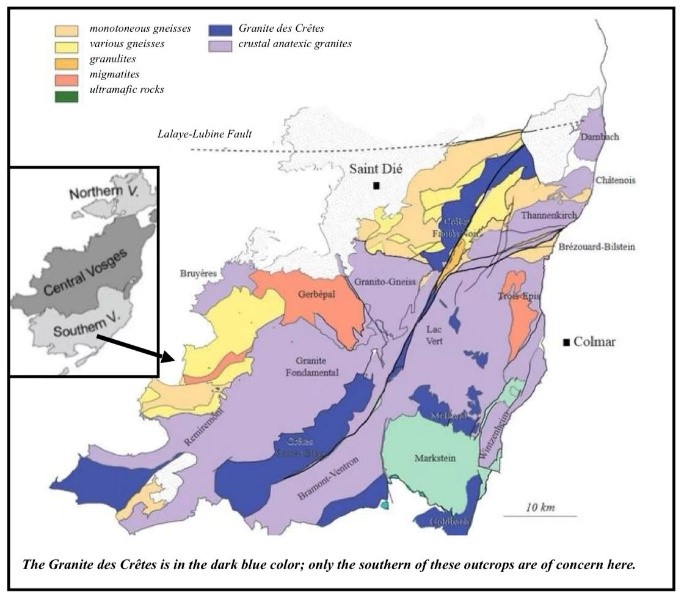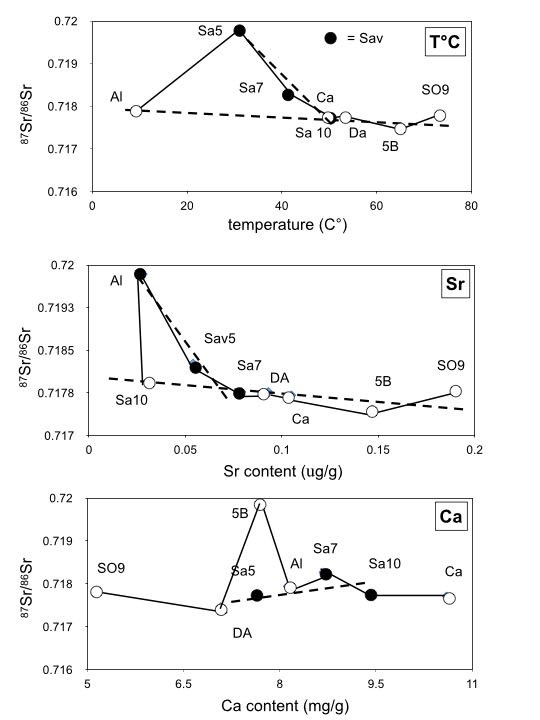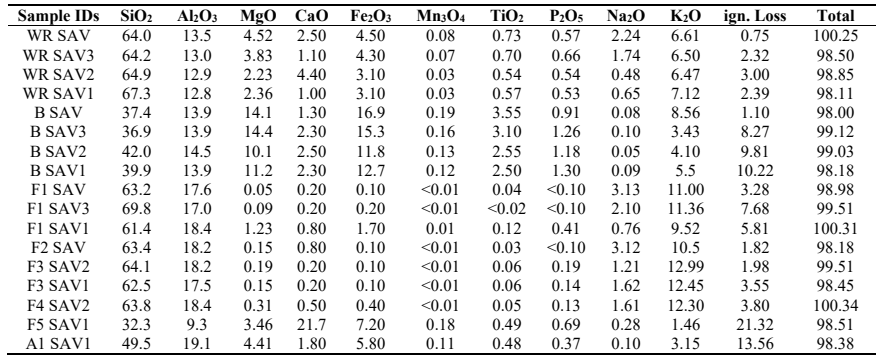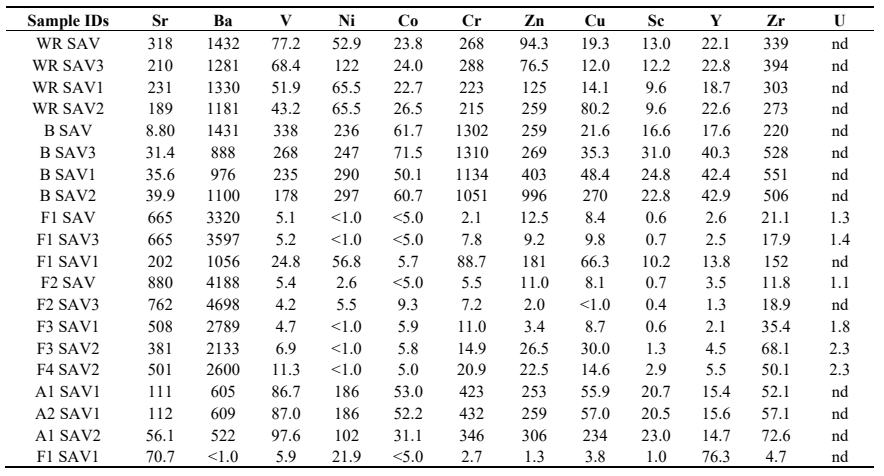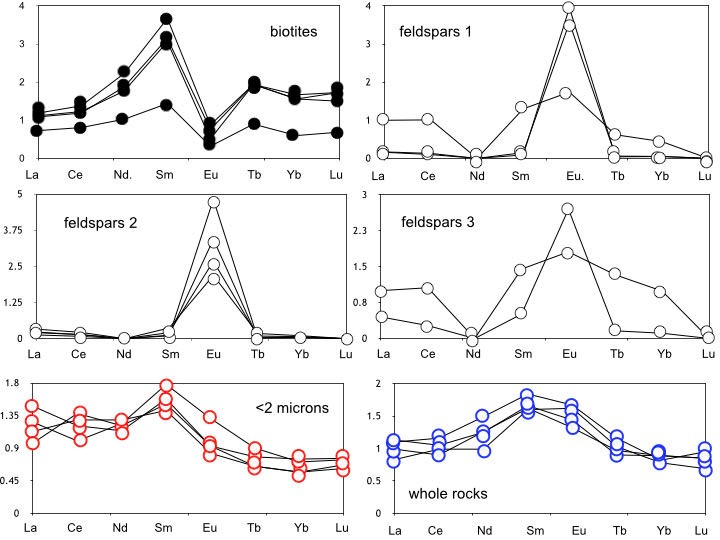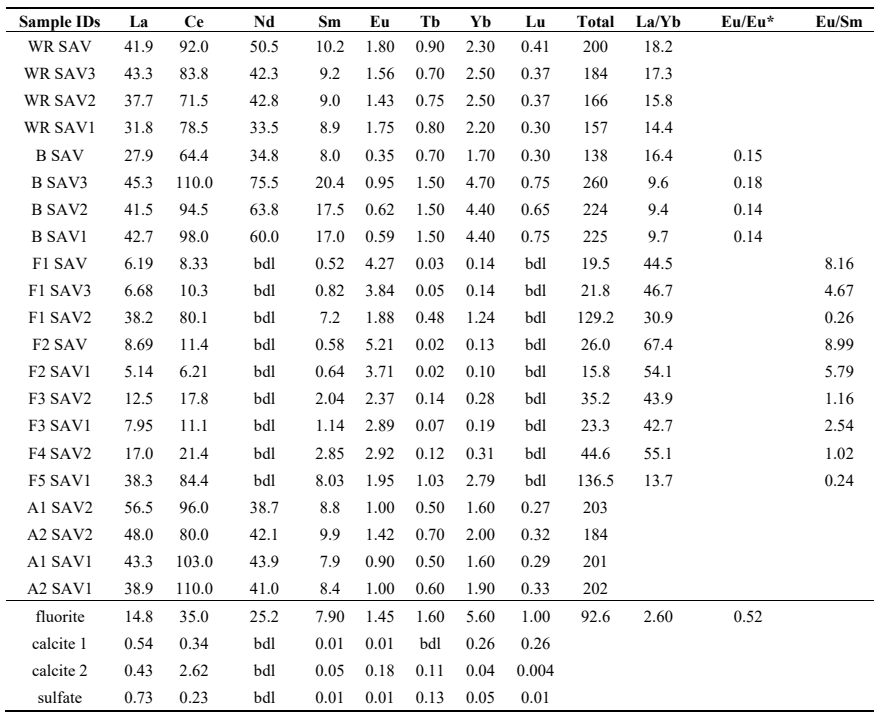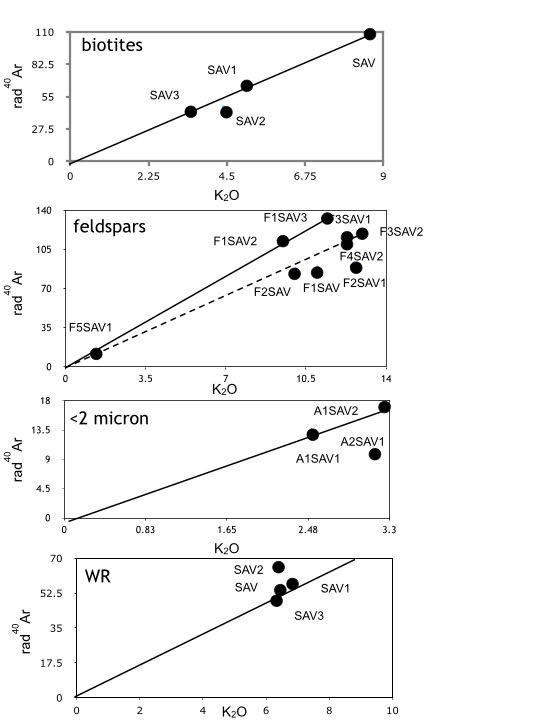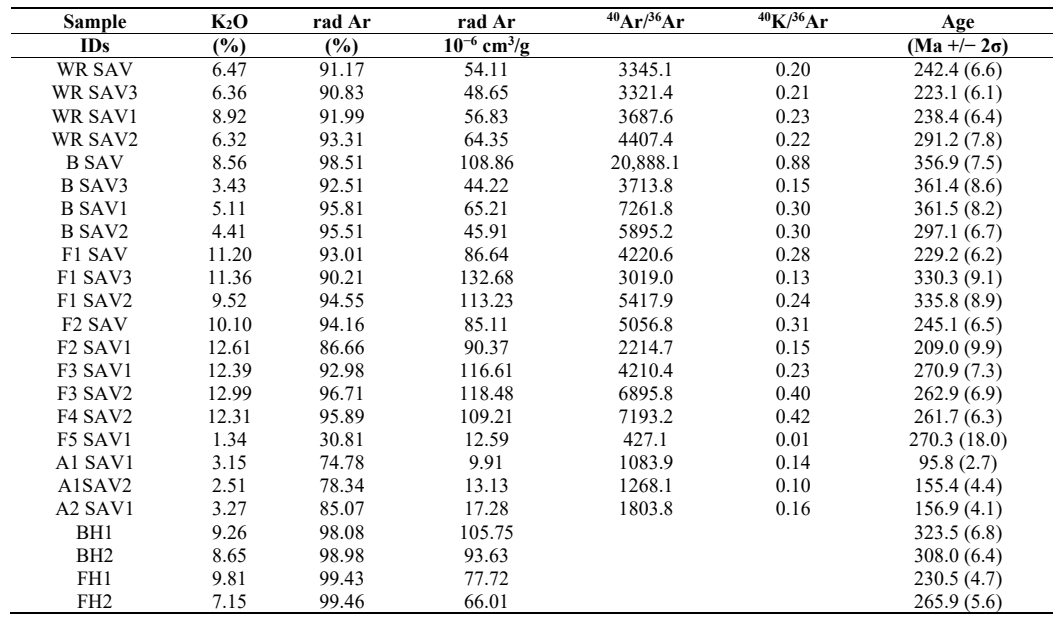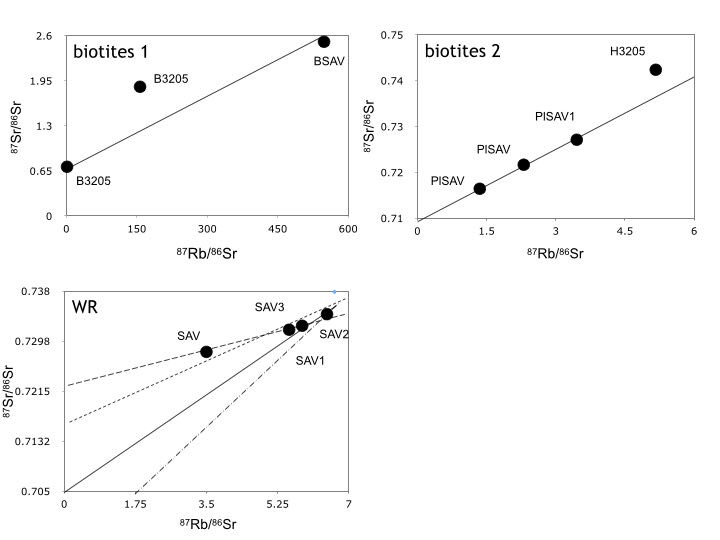Download PDF
Cite This Article
Contents
Evaluation of a Present-Day Thermal Activity on the Constitutive Minerals of a Granite and of Its Impact on the Whole-Rock Sealing Potentials
Author Information
Other Information
Institut des Sciences de la Terre et de l’Environnement de Strasbourg, Université de Strasbourg (UdS/CNRS), 67084 Strasbourg, France
*
Authors to whom correspondence should be addressed.
Received: 30 April 2024 Accepted: 29 July 2024 Published: 06 August 2024
© 2024 The authors. This is an open access article under the Creative Commons Attribution 4.0 International License (https://creativecommons.org/licenses/by/4.0/).
Clean Energy Sustain.
2024,
2(3), 10013;
DOI: 10.35534/ces.2024.10013
ABSTRACT:
Mineralogical and chemical analyses of the major constitutive minerals from granite des Crêtes collected near the thermal site of Plombières-les-Bains
(Vosges Mountains, eastern France) clearly show that recently circulating
thermal waters up to 90 °C do not impact them. Even the constitutive minerals
smaller than 2 microns are not affected. As a result, all minerals reflect the
entire complex tectonic-thermal history of the granitic massif rather than just
the recent thermal impact. Only the open faults and natural drains contain
calcite from recent thermal waters. This is confirmed by similar calcite
deposits with the same elemental contents sampled in the pipes of thermal installations. As a complementary conclusion, storage of
containers of nuclear waste that diffuse an overall temperature up to 100 °C
will not alter the potential sealing properties of a plutonic host massif, of
course, without any recent thermal drainage that could potentially spread
radioactive waste. This conclusion was already obtained on a moderately faulted
sedimentary environment after a one-year in-situ heating experiment at about
100 °C. Calcium is a key indicator of low thermal impact. After an initial
decrease, its levels rose significantly in the most "altered" granite samples, inducing calcite precipitation, even in the water pipes at the thermal site. The negligible impact of a
hydro-thermal activity at a maximum of about 100 °C in a granitic material
represents, indeed, a piece of useful information, as deep sites for nuclear
waste in plutonic host rocks appear to act, also, as potential isolated host
systems.
Keywords:
Thermal waters; Plombières-les-Bains site; Granite des Crêtes; Vosges
Mountains (France); Constitutive minerals; Granites as potential deep
repositories
1. Introduction
Thermal waters represent substantial assets of entire regions due to their implications for basic human health and prosperity and for economic applications in terms of industrial and touristic aspects. This is the case in France, where numerous well-known thermal cities, for instance, are located on plutonic or sedimentary geological grounds all over the country. Incidentally, a supplementary technical application about host rocks affected by thermal water propagation came up in the necessary safety evaluation of deep-storage nuclear waste, known now to induce a “storage” temperature of about 100 °C to its immediate environment.
The site of interest in the context of a potential alteration induced by circulating thermal waters is that of Plombières-les-Bains located in the southern crystalline Vosges Mountains (northeastern France). About 2000 years ago, the Romans “discovered” warm flowing waters there, where they constructed a site that was almost completely destroyed later during the Barbarian invasions. Reconstructed during the Middle Ages, the thermal site remains operational today, including 37 natural springs, 27 of them providing thermal waters between 9 and 80 °C with low elemental charges and therefore applicable to diverse health therapies [1]. The thermal city of Plombières-les-Bains is located on the granitic “Massif des Crêtes” basement that extends on the western side of the southern Vosges Mountains (Figure 1). Based on an U-Pb dating, the emplacement of this massif occurred 337.2 ± 1.8 Ma ago [2]. It was subjected to an extensive hydrothermal alteration, some of the local massifs being also impacted by late magmatic hypo-volcanic activities. This mixed impact induced some alteration mainly characterized by a degradation of the amphiboles and the initial plagioclases, while the biotite crystals appeared to be only slightly affected [3]. The granitic massif was also subjected to a recent, low-temperature thermal alteration, whose impact can be followed along the visible tectonic accidents that behave, therefore, as drains for the recent thermal waters.
In this context, the following geochemical and isotopic study was designed to test if this thermal activity could have modified the major and trace elemental compositions, as well as the isotopic (Rb-Sr and K-Ar) signatures of the main and the accessory minerals of this Massif des Crêtes that underwent, also, an early tectonic-thermal alteration. Another interest of such a study is in connection with studies about long-term nuclear waste repositories in granite-type potential sites. Indeed, such engineering/technical studies included recent long-term low-heating experiments to evaluate the potential impact of the stored waste itself. Preliminary results have shown that the heating of potential sedimentary host-sequences over one year at about 100 °C did not induce detectable mineralogical/chemical alterations [4]. In this context, the impact of a thermal activity of about the same intensity in a granitic environment may represent a substantial information, as deep repository sites of such waste are also evaluated in plutonic environments (i.e., [5]).
Figure 1. Simplified geological map of the southern Vosges Mountains. The Granite des Crêtes is in dark blue; the southern of these outcrops are of concern here.
2. Geological Setting of the Granitic Massif
The crystalline basement of concern belongs to the granitic Massif des Crêtes, with most major outcrops to the East in the Bresse Massif and over 60 km along the Sainte-Marie-aux-Mines fault to the NE (Figure 1). This massif represents a plutonic assemblage extensively studied for many years [3,6,7,8,9,10]. An important hydrothermal alteration impacted some massifs of this assemblage, mostly induced by tardi-magmatic hypo-volcanic activities that induced some high-temperature alteration. For Hameurt [9], the granite des Crêtes is younger than all regional crystalline terrains that it crosscuts partly. Some early geochronological studies located its isotopic age between 350 and 320 Ma [11,12,13]. A more recent U-Pb study on separated zircons gave a more precise age of 337.2 ± 1.8 Ma [10].
Later, this granite des Crêtes was pervasively subjected to a tectonic-thermal event along the N60 and N140-170 directions. Characterized by intense mineral transformations, including some rock crushing, these zones belong to concomitant fractures. The early hydrothermal alterations were compatible with biotite preservation and are characterized by: (1) a precipitation of chlorite and calcite at the expenses of framework actinolite, (2) a saussuritization with a sericite-calcite-quartz assemblage, (3) a precipitation of basic plagioclases, and (4) a sericitization of the oligoclase-type plagioclases [9]. In addition to sub-recent “drains” and thermal water springs, the granite also shows typical transformations, including microcrystalline aggregates of hematite, chlorite, and sericite. Fluorite also impregnates the rock matrix or forms independent veins. Only the calcite coatings appear later than the fluorite coatings.
3. Sampling and Analytical Procedure
Four granitic rocks were selected on the Plombières thermal site, with an additional sample collected away from recent to present-day thermal activity as the non-affected reference material. This reference sample collected farthest from the thermal site, consists of 35% quartz, 20% K-feldspar, 30% plagioclase and 15% biotite.The altered rock types (labeled SAV1, SAV2 and SAV3) were collected at the Plombières-les-Bains site in the extensively altered “Galerie des Savonneuses” that was constructed to facilitate the access to the major thermal springs with the highest local water supply. Sample SAV2, for instance, consists of 25% quartz, 10% K-feldspar, 15% plagioclases, 5% biotite and up to 45% clay-type material. Three thermal waters were also collected in the gallery at temperatures between 50 and 20 °C, complementing earlier analyses [14]. Permanent maintenance by the thermal society in charge of the exploitation material also allowed the sampling of carbonated crusts coating the inside of old man-made water pipes.
The whole rocks were crushed by hand and sieved at 135 meshes. Biotite and several types of feldspars were separated using dense liquids. The different feldspar separates correspond in fact to material that settled successively by changing the density of the used liquids. Clay material, calcite and fluorite were also separated from whole-rock samples. The contents of the major and traces elements were determined by inductively coupled plasma-atomic emission spectrometry (ICP-AES) and inductively coupled plasma-mass spectrometry (ICP-MS), respectively, following the procedure of Samuel et al. [15]. The accuracy of the analytical equipment was regularly checked by repeatedly analyzing the international mineral standards GL-O and BE-N.Their systematic analysis allowed them to set the analytical uncertainty at ±2.5% for the major and ±5% for the trace elements.
The Ar extractions were made in a glass line following a method described by Bonhomme et al. [16]. The samples were preheated under vacuum at 80 °C for at least 12 h to remove the atmospheric Ar adsorbed on the sample and mineral powders during preparation, separation and handling. Potassium was measured by flame spectro-photometry with a reproducibility better than 1.5%. The analytical precision of the Ar extraction was periodically controlled by measuring the international glauconite standard GL-O, giving an average of 24.59 ± 0.17 (2σ) × 10−6 cm3/g (STP) of radiogenic 40Ar for 5 independent measurements at the time of the study, the recommended amount being 24.85 ± 0.48 × 10−6cm3/g [17]. The systematic control of the procedure also included periodic determinations of the atmospheric 40Ar/36Ar ratio that averaged 289.7 ± 1.2 (2σ) at the time of the experiment, the recommended value being 298.6 ± 0.4 [18]. Because of the expected limited changes in the amounts of radiogenic 40Ar due to the natural hydrothermal alteration, the extraction line and mass spectrometer blanks were also determined systematically before each Ar determination. These blanks never exceeded 1 × 10−8 radiogenic 40Ar. The K-Ar ages were calculated using the recommended decay constants [19] with an overall estimated analytical precision of about ±2.5%.
The Rb-Sr isotopic procedure is close to that of Schaltegger et al. [20], including a Sr purification by resin chromatography and analysis on a thermo-ionization mass spectrometer with five mobile collectors for analysis of the Sr isotope composition and concentration. In contrast, the amounts of Rb were determined on a second mass spectrometer with a single collector. The analytical precision of the procedure was periodically controlled by analysis of the 87Sr/86Sr ratio of the NBS 987 standard that averaged 0.710257 ± 0.000015 (2σmean) for 4 independent determinations during the study. The Rb-Sr data were calculated with the usual decay constants [19].
4. Results
The driving factor of the potential low-temperature alteration of the major constitutive minerals from granitic massif being the thermal waters, their analysis was included in the geochemical study.
4.1. Some Geochemical Information of the Thermal Waters
Eight thermal waters were collected at temperatures ranging between 9.9 and 73.0 °C [14] (Table 1). Their 87Sr/86Sr ratios range between 0.71972 ± 0.00007 (2σ) for the water at 31.5 °C and 0.71746 ± 0.00012 for that at 65 °C (Figure 2). In detail, the three waters collected next to each other in the Galerie des Savonneuses yield a significant increase in their 87Sr/86Sr ratio when the temperature decreases from 50 to 30 °C. This negative correlation with the temperature suggests a mixing of waters at various temperatures and with various Sr isotopic ratios. The 87Sr/86Sr ratio also increases slightly when the Sr content decreases (Figure 2) while remaining about constant, except for one value, when the Ca content changes (Figure 2). Interestingly, the Sr contents also decrease in the other Savonneuses thermal waters when the temperature decreases.
4.2. The Elemental Contents of the Whole Rocks and the Separated Minerals
The changing contents of the major minerals of the rocks were evaluated before and after the impact of the alteration on the minerals by examining the compositions of the whole rocks. For the biotite separates, the major elements either accumulate, such as Si and Ca, or decrease, such as Mg, Ti, Fe and Mn (Table 2). The concentrations of most trace elements (Rb, Ni, Sc, Zr, Y, Zn and Cu) increase when alteration increases; only those of Ba and Sr decrease. The most visible changes occur for Ba, Sc, Y and Zr at the beginning of the alteration. At the same time, Sr increases rapidly at the beginning and less afterward, Ni, Zn and Cu accumulate slowly at the starting alteration and faster afterward.
The behavior of the constitutive elements from feldspars is more difficult to delineate, probably because the obtained separates do not strictly represent pure mineral fractions, depending rather on the global density of the crystals relative to the used dense liquids. This means, in turn, that most selected feldspar fractions, for instance, are probably mixtures of more or less pristine with more or less weathered crystals. However, based on the Na, K and Ca contents, most feldspar separates are of the microcline type and only the fraction F5 of sample SAV1 seems to be of a plagioclase type. The K2O contents are systematically high beyond 11%, which tends to state that the separated feldspar fractions appear rather pristine, as expected. Clauer [21] raised this aspect in a study of feldspars affected by continental weathering, which suggests that the apparent “freshness” probably results from the separation and purification procedure of the minerals. The classical separation technique appears to remove fresh parts of the grains instead of the altered/weathered parts. This likely happens because the fresh parts are coarser and harder to remove, while the altered parts are finer and easier to separate. As a result, the weathered parts are more easily disintegrated and removed from the clean cores, and are lost during the separation process using heavy liquids. This is somehow confirmed by the low ignition loss, often below 3.5wt%, for the feldspar fractions of the weathered rocks. In sum, the thermal alteration decreases the Si, Na and K contents and an increase of the Al, Mg, Ca and Fe ones (Table 2). Among the trace elements, the contents of Sr and Ba decrease, whereas those of V, Co, Cr, Zn, Cu, Y and Zr increase.
The contents of the major elements of the fresh whole rock analyzed here agree with the published average analysis of 25 rock samples from the same granite des Crêtes [3]. By taking the increasing ignition loss as the alteration indicator, the rock samples selected here follow the sequence SAV to SAV3, SAV1 and SAV2 (Table 2) that has been adopted hereafter to follow the modifications due to the expected recent-to-present-day thermal alteration of the different minerals and, consequently, of the whole rocks when combined. Relative to Al, the contents of Si and K increase, while those of Ti, Fe, Mg Mn and Na decrease in this alteration succession (Table 2). The behavior of Ca is more complex: its content decreases first and increases again significantly in the most altered rock, which suggests an initial leaching followed by a late crystallization of calcite wherever the alteration process becomes dominant. The behavior of the trace elements is also variable: Ba, Sr and Mn appear to have been leached from the rocks in that order when alteration progresses, while Ni, Zn and Cu tend to accumulate (Table 3).
For the rare-earth elements with an analytical precision set at +/−10%, it is probably appropriate to briefly recall some of their specific aspects, which in turn explain their distribution and individual behavior. For instance, their geochemical behavior is based on a continuous variation of their ionic radius, as well as on specific complexation capacities of two of them with changes in their redox state: cerium occurs as Ce3+ and Ce4+ and europium as Eu2+ and Eu3+. Also to be remembered are the facts that: (1) Eu is specifically related to plagioclase crystals and their alteration products in surface and sub-surface processes, and (2) the rare-earth elemental (labeled REE hereafter) patterns characterizing upper-crustal materials are often very uniform [22], which is easily tested by comparing them to an international reference, such as the chondrites [23], the Post-Archean Australian Shales [24], or the North-American Shale Composites [25]. The two latter patterns are mostly used in the study of terrestrial supergene products, the Post-Archean Australian Shales (labelled PAAS hereafter) reference having been chosen here rather than that of the reference chondrite. The reason is that it is easier to decrypt an almost flat global comparison spectrum than that relative to chondrites, which are inclined and often need a logarithmic frequency scale, making the variations less easy to read. The PAAS patterns often show negative Eu anomalies due to different oxidation-reduction conditions. They also display positive Ce anomalies, which indicate the selective partitioning caused by plagioclase minerals or their weathering products.
It is also important to remember the analytical uncertainties of REEs due to the mentioned interferences and to their very low concentrations. For these reasons, only eight REEs were systematically analyzed in this study (Table 4), some REEs remaining below the detection limits of the used equipment. Internal reproducibility was controlled weekly by analyzing international standards, as mentioned earlier. Relative to the PAAS reference, the REE of the biotite separates outlines about similar patterns with a positive Sm and a negative Eu anomaly (Figure 3). The amounts of the SAV biotite are lower but with the same distribution pattern as for the three other biotite separates. For the feldspars, all patterns except two are similar again, with an expected positive Eu anomaly and very flat displays around (Figure 3). The two feldspar separates with different distribution patterns are F1 from SAV2 rock and F5 from SAV1 rock. They display two successive “bulky” patterns centered on the Ce and Eu elements with contents below the detection limit for Nd and Lu. In the case of the clay fractions, in which crystallization is delayed relative to the emplacement of the granitic body, as will be shown hereunder, the separates yield a homogeneous pattern different from those of the biotites and the feldspars (Figure 3). A positive Sm anomaly with two smooth decreases on both sides, that of the light REEs (labeled LREEs) being slightly higher than that of the heavy REEs (labeled HREEs). In turn, the different samples yield similar patterns that do not distinguish those of the altered from those of the fresh whole-rock samples (Figure 3). All patterns display a kind of symmetric bulk distribution centered on the higher Sm and Eu anomalies with ratios of the LREEs and HREEs at similar values.
4.3. The K-Ar Data of the Separated Minerals and the Whole Rocks
An appropriate way to visualize and identify the minerals that were affected by an alteration or weathering action is a comparison of their K and radiogenic 40Ar contents in a Harper diagram [25] and also to transfer the results into an isochron display. This procedure is effective for distinguishing fresh minerals from altered ones and for assessing the overall impact of alteration on the whole-rock data.
The K-Ar system of the SAV, SAV1 and SAV3 biotites outlines equivalent contents for both the K and radiogenic 40Ar, as the data points plot along a line crossing the two coordinates at their initials, while those of SAV2 plot below (Table 5; Figure 4). It is, therefore, probable that the three biotite separates with their data points on the line crossing the two coordinates at their origins are fresh and that their average K-Ar age of 366.9 ± 2.7 Ma is at or close to the emplacement time of the granitic massif. It can also be stated that the biotite SAV2 located below this line of equivalent contents has been altered. The data of the feldspars are more dispersed than those of the biotite extracts, probably due to the previously mentioned separation problems. The highest values obtained are for F1 of the SAV3 and F1 of the SAV2 fraction average of 333.0 ± 2.7 Ma (Figure 4), slightly below the average age of the biotite separates. Even lower values were obtained for the separate F1 of the rock SAV and F2 of SAV1 at 229–209 Ma. Two other feldspar fractions yield K-Ar data slightly higher, at 245.1 ± 6.5 Ma for F2 of the SAV sample. A last set of feldspar separates, including F3 of SAV1, F3 of SAV3, F4 of SAV2 and F5 of SAV1 provide an intermediate average age value of 266.5 ± 4.4 Ma. The combined K-Ar data of the fine A1 separate of SAV and the same A2 separate of the SAV1 sample, plot on a line intersecting the origin of the two coordinates with a data of 156.1 ± 0.7 Ma (Figure 4). The third A1 fraction smaller than 2 microns of sample SAV1 plots below that line and yields even younger age data.
The entire dataset and, therefore, the various mineral behaviors impact the results of the four whole rocks. The data points of the SAV, SAV1 and SAV3 samples plot along a line in the Harper diagram [25] that intersects both coordinates at their origins (Figure 4), meaning an homogeneous distribution of K and the 40Ar. The average age of 235 ± 10 Ma for these three samples is far younger than that of the massif emplacement. Therefore, it can be concluded that these whole rocks were affected after emplacement by an invasive altering event. The fourth studied whole rock yields a data point that plots above the line defined by the three other data points. Its age of 291.2 ± 7.8 Ma is still slightly younger than that of the emplacement evaluated above. It probably refers to an earlier and/or less altering combination unless it results from an individual excess of radiogenic 40Ar relative to its overall K content.
4.4. The Rb-Sr Results
The set of Rb-Sr data, including those of the whole rocks, the biotites, the feldspars and of the clay separates, as well as those of the calcite from the water pipe and those from nearby Granite des Crêtes already published [14] fit a common array except the data of the biotite separates (Table 6; Figure 5). When the scale is enlarged and the focus is on the lower cluster of points, additional data points appear outside the initial range (Figure 5). In detail, the data of the whole-rocks are slightly dispersed in the Rb-Sr diagram, which confirms the occurrence of various late disturbing tectonic-thermal events on the Rb-Sr systematics of its mineral carriers.
Figure 2. The <sup>87</sup>Sr/<sup>86</sup>Sr ratio of the Plombières thermal waters relative to their temperature (<b>top</b>), the Sr contents (<b>middle</b>) and the Ca contents (<b>bottom</b>). The black dots are for the waters collected in the galerie des Savonneuses and the empty dots for waters collected elsewhere in the massif.
Table 1. Data of the collected thermal waters and of the calcite from a hydrothermal pipe. IDs stands for identities.
Table 2. Major elemental compositions of the feldspars, biotites, <2 micron fractions and whole rocks of the Plombières granite. The contents are in weight per cent (%wt). IDs stands for identities, WR for whole rock, B for biotite, F for feldspar, A for <2 micron fraction and ign loss for igneous loss.
Table 3. Contents in ug/g of the trace elements from separated minerals, size fractions and whole rocks of the Plombières granite. IDs stands for identities, WR for whole rock, B for biotite, F for feldspar, A for <2 micron fraction and nd for not determined.
Figure 3. Rare earth elemental patterns of the separated feldspars, biotites, <2 micron fractions and whole rocks from Plombières granite relative to the Post-Archean Australian Shales reference.
Table 4. Contents in ug/g of the rare-earth elements from minerals, size fractions and whole rocks of the Plombières granite. IDs stands for identities, WR for whole rock, B for biotite, F for feldspar and A for <2 micron fractions; bdl means below detection limit and Eu* means Eu reference content The fluorite, calcite and sulfate at the bottom of the table are from nearby Plombières granites.
Figure 4. K-Ar data of the feldspars, biotites, <2 micron fractions and whole rocks of the Plombières granite. The dotted line outlines a second plausible numerical age.
Table 5. K-Ar data from feldspars, biotites, <2 micron fractions and whole rocks of the Plombières granite. IDs stands for identities, WR for whole rock, B for biotite, F for feldspar, A for <2 micron fractions. The B and F samples at the bottom of the table are representative of biotite and feldspar analyses made earlier on material from nearby granites.
Table 6. Rb-Sr data from feldspars, biotites, <2 micron fractions and whole rocks of the Plombières granite. IDs stands for identities, WR for whole rock, B for biotite, F for feldspar, A for <2 micron fractions. WR3343 is a carbonate from a water pipe of the thermal site and calcite 3342 is its purified calcite. B, F and H3205 are pure biotite, feldspar and hornblende separates from Plombières granite at the nearby Sainte Marie site.
Figure 5. Rb-Sr data of the biotites and whole rocks of the Plombières granite. The straight lines are apparently isochrons suggesting equivalent isotopic ratios. The dashed lines suggest mixings of at least two generations of minerals.
5. Discussion
5.1. What About the History of the Granite des Crêtes?
The Granite de Plombières was subjected to a complex post-plutonic history based on the various isotopic ages obtained for its constitutive, more or less pristine minerals. The K-Ar ages of the fresh feldspars range from 230 to 245 Ma, supporting a regional, quite intense post-Variscan plutonic activity (Table 6). Alternatively to this age range, the biotite separates are older at 357 ± 8 Ma, within the timing of the probable Variscan emplacement. These results are supported by the K-Ar ages of 308 to 324 Ma for biotite separates of two nearby Crêtes and Grosse-Pierre granite bodies and the 230 to 265 Ma ages for feldspars of similar granites [26]. Consequently, the K-Ar age of the whole rocks appears to be mostly controlled by the feldspars with an average value of about 242 Ma. In turn, all these results are far too high to be assigned to a recent-to-present-day low-thermal alteration.
Some of the expected altered feldspars fall within the 262–271 Ma range. These can be considered fresh remainders after separating and removing the altered outer layers and skins. This could have been the case for the separated F3 of the SAV2 rock, F3 of the SAV1 rock, F4 of the SAV2 rock and F5 of the SAV1 rock. The other altered feldspar splits yield K-Ar ages that either increased, as is the case for F1 of the SAV3 rock and F1 of the SAV2 rock, or decreased, as is the case for the separate F2 of the SAV1 rock.
The <2 micron fractions mostly consisting of clay-type material, resulted probably from a lower-temperature hydrothermal alteration with K-Ar ages systematically younger than either those of the host rocks or those of the associated biotite and feldspar separates. The results suggest an authigenesis of these clay-type crystals, possibly about 155 Ma ago, for the A1 and A2 of respectively the SAV2 and SAV1 separates. Unless their crystallization occurred later, around 96 Ma, as seen in the A1 of the SAV1 fraction, which includes higher age data for some associated older crystals. On the other hand, it cannot be denied that these clay-type fractions could have also been somehow altered by the present-day thermal activity. At least they represent a fraction of granitic rocks susceptible to record the very discrete low-temperature alteration that may affect the upper layers of such rock massif.
5.2. What About the Impact of Thermal Waters on the Retention Qualities of a Granite?
Opinions about the possibility of granites to act as safe repositories for nuclear waste are presently quite numerous. However, determining conclusions based on detailed research appears to be still not enough, even if some appear very convincing (e.g., [27]). The purpose here is not to add definitive arguments but to provide more evidence for the very sensitive and determining topic of the deep storage of such waste. Previous studies have shown that metallic containers filled with nuclear waste reach a surrounding temperature of about 100 °C by self-heating (e.g., [28]). Heating locally potential clay-type host sediments have also already shown that such temperature does not affect the sealing potentials of the studied sedimentary host sequence [4]. In this context, the purpose here is to prove if such basic storage temperature affects the sealing qualities of potential granite-type host material.
The impact of sub-actual thermal waters at temperatures up to about 100 °C and circulating in a granitic host-massif seems to be an appropriate objective to detail, as they add transportation aspects to a potential alteration of the constitutive minerals. The mineralogical, chemical and isotopic data obtained in the present study do not support an impact of the present-day thermal waters on the major minerals of the regional outcrops of the granite des Crêtes. Alternatively, the recent deposition of calcite, even in the pipes of the thermal installations, obviously resulted from dispersion and deposition of circulating thermal waters, their temperature being certainly a determining factor of its crystallization, while not high enough to alter the constitutive minerals. This carbonate is most likely from a source external to the granite, such as meteoric water, before entering the plutonic massif. However, discrete leaching of Ca from feldspars altered earlier by late plutonic activity cannot be excluded.
As a partial conclusion, it can be assumed that the recent to present-day thermal activity in the granite did not affect its retention capabilities as none of the constitutive minerals seem to have been affected, as did not the late <2 micron crystals. However, it cannot be excluded either that the occurrence of waters from outside of granites penetrated the massif, were heated to temperatures of about those determined here and have facilitated the dispersion of free elements, such as radioactive compounds potentially released from altered containers, in plutonic rocks visited by waters from outside the granitic massif after late tectonic-thermal episodes.
6. Conclusions
The mineralogical and chemical analyses of the main constitutive minerals of the granite des Crêtes near Plombières-les-Bains clearly show that they are not affected by the inflow of recent thermal waters. Even the lately crystallized phyllo-silicate minerals smaller than 2 microns are not affected. They all detail the complex tectonic-thermal history of the granitic massif without any evidence of recent thermal impact on the minerals. Only the open faults and the drains of the massif contain calcite deposited from the running thermal waters, which is confirmed by their deposits in the sub-actual water pipes of the local thermal installations.
It can be concluded that storing nuclear waste at temperatures up to 100 °C will not affect a potential plutonic host massif, provided there are no migrating fluids of any temperature present. Such a conclusion was already obtained after a one-year heating experiment at about 100 °C in a sedimentary environment in slight tectonic conditions. The behavior of Ca is somehow a clear confirmation of the discrete low-temperated thermal event: after decreasing first, its content increases significantly in the granitic rock samples containing the most Ca-carbonate, which confirms a late to recent crystallization of calcite while such alteration becomes dominant, also in human-made water pipes. The minimal impact of thermal activity, with temperatures up to 100 °C, is significant. Deep storage sites for nuclear waste in plutonic host rocks remain stable and function as closed systems as long as they are not infiltrated by recent moving fluids.
Acknowledgments
The following colleagues deserve heartily thanks for various reasons; Dr. D. Jeannette for his personal contribution to this study and his overall interest for isotope geochemistry, D. Tisserant for mineral separation and sample preparation for the chemical and isotopic determinations, Rob. Wendling for the clay separations, Ray. Wendling and Ray. Winkler for the Ar determinations, B. Kiefel for the Rb-Sr determinations and J. Samuel for the elemental determinations. I would also like to thank sincerely one of the two anonymous reviewers who helped improving substantially the content and the present message.
Ethics Statement
Not applicable.
Informed Consent Statement
Not applicable.
Funding
This research received no external funding.
Declaration of Competing Interest
No specific or personal interest by the author.
References
1.
Gijbels R, Van Grieken R, Blommaert W, Vandelannoote LR, Van’t Dack L. Trace element geochemistry in thermal waters from Plombieres and Bains (Vosges). In Advances in European Geothermal Research; Springer Verlag: Heidelberg, Germany, 1980; pp. 396–409.
2.
Tabaud A-S, Janoušek V, Skrzypek E, Schulmann K, Rossi P, Whitechurch H, et al. Chronology, petrogenesis and heat sources for successive Carboniferous magmatic events in the Southern–Central Variscan Vosges Mts (NE France). J. Geol. Soc. Lond. 2015, 172, 87–102. [Google Scholar]
3.
Gagny C. Vaugnérites et durbachites sont des cumulats de magmas granitiques (l’exemple du magma des Crêtes); Comptes Rendus de l’Académie des Sciences: Paris, France, 1978; Volume 287, pp. 1361–1364.
4.
Clauer N, Honty M, Frederickx L, Nussbaum C. Evaluation of a long-term thermal load on the sealing characteristics of potential sediments for a deep radioactive waste disposal. Sustainability 2022, 14, 14004. [Google Scholar]
5.
Laverov NP, Omel’yanenko BI, Yudintsev SV. Crystalline rocks as medium for nuclear wast disposal. Russ. J. Gen. Chem. 2011, 81, 1980–1993. [Google Scholar]
6.
Groth P. Das Gneiss-Gebiet von Markich im Ober-Elsass. Abh. Der Geol. Spezialkarte Elsass-Lothr. 1877, 1, 484–485. [Google Scholar]
7.
von Eller J-P. Les gneiss de Sainte-Marie-aux-Mines et les séries voisines des Vosges moyennes. Mémoires du Service de la Carte Géologique d’Alsace et de Lorraine; Institut de Géologie de l’Université: Strasbourg, France, 1961; Volume 19, p. 169.
8.
Simmler F. Le granite des Cretes de Sainte-Marie-aux-Mines. Etude pétrographique et minéralogique. Sci. Géologiques 1962, 15, 81–126. [Google Scholar]
9.
Hameurt J. Les granites des Vosges moyennes: Un exemple de granites de cratons formés par palingenèses successives. Sci. Géologiques Bulletins et Mémoires 1967, 20–23, 185–194. [Google Scholar]
10.
Tabaud A-S, Whitechurch H, Rossi P, Schulmann K, Guerrot C, Cocherie A. Devonian–Permian Magmatic Pulses in the Northern Vosges Mountains (NE France): Result of Continuous Subduction of the Rhenohercynian Ocean and Avalonian Passive Margin; Special Publications; Geological Society: London, UK, 2014; Volume 405, pp. 197–223.
11.
Bonhomme M. Ages radiométriques de quelques granites des Vosges moyennes. Bull. du Service de la Carte Géologique d’Alsace-Lorraine 1967, 20, 101–106. [Google Scholar]
12.
Hameurt J, Vidal P. Contribution de la géochimie isotopique du strontium à la connaissance du socle des Vosges moyennes. Bull. de la Société Géologique de France 1973, XV, 246–251. [Google Scholar]
13.
Montigny R, Schneider C, Royer JY, Thuizat R. K-Ar dating of some plutonic rocks of the Vosges, France. Terra Cognita 1983, 3, 201. [Google Scholar]
14.
Fritz B, Clauer N, Jeannette D. Etude géochimique et pétrographique de dépôts hydrothermaux de quartz, fluorine et calcite le long des fractures dans le granite de Plombières-les-Bains (Vosges, France). Bull. BRGM 1982, 2, 383–392. [Google Scholar]
15.
Samuel J, Rouault R, Besnus Y. Analyse multi-élémentaire standardisée des matériaux géologiques en spectrométrie d’émission par plasma à couplage inductif. Analusis 1985, 13, 312–317. [Google Scholar]
16.
Bonhomme M, Thuizat R, Pinault Y, Clauer N, Wendling R, Winkler R. Méthode de Datation Potassium-Argon. Appareillage et Technique; Technical report of the Centre de Géochimie de la Surface; Université Louis Pasteur: Strasbourg, France, 1975; 53p.
17.
Odin and 36 Collaborators. Interlaboratory standards for dating purposes. In Numerical Dating in Stratigraphy, Part 1; Odin GS, Ed.; John Wiley & Sons: Chichester, UK, 1982; 123–148.
18.
Lee JY, Marti K, Severinghaus JP, Kawamura K, Yoo HS, Lee JB, et al. A redetermination of the isotopic abundances of atmospheric Ar. Geochim. et Cosmochim. Acta 2006, 70, 4507–4512. [Google Scholar]
19.
Steiger R, Jäger E. Subcomission on Geochronology: Convention on the use of decay constants in geo- and cosmochronology. Earth Planet. Sci. Lett. 1977, 36, 359–362. [Google Scholar]
20.
Schaltegger U, Stille P, Rais N, Piqué A, Clauer N. Nd and Sr isotopic dating of diagenesis and low-grade metamorphism of argillaceous sediments. Geochim. et Cosmochim. Acta 1994, 58, 1471–1481. [Google Scholar]
21.
Clauer N. Strontium and argon isotopes in naturally weathered biotites, muscovites and feldspars. Chem. Geol. 1981, 31, 325–334. [Google Scholar]
22.
McLennan SM. Rare earth elements in sedimentary rocks: Influence of provenance and sedimentary processes. In Geochemistry and Mineralogy of Rare Earth Elements; Reviews in Mineralogy, 21; Lipin BR, McKay GA, Eds.; Mineralogical Society of America, Chantilly, VA, USA, 1989; pp. 169–200.
23.
Evensen NM, Hamilton PJ, O’Nions RK. Rare-earth abundances in chondritic meteorites. Geochim. et Cosmochim. Acta 1978, 42, 1199–1212. [Google Scholar]
24.
Gromet LP, Haskin LA, Korotev RL, Dymek RF. The “North American shale composite”: Its compilation, major and trace element characteristics. Geochim. et Cosmochim. Acta 1984, 48, 2469–2482. [Google Scholar]
25.
Harper CT. Graphic solution to the problem of 40Ar loss from metamorphic minerals. Eclogae Geol. Helv. 1970, 63, 119–140. [Google Scholar]
26.
Boutin R, Montigny R, Thuizat R. K-Ar and 39Ar-40Ar chronology of metamorphism and magmatism of the Vosges. Comparison with adjacent Variscan massifs. Geologie de la France. 1995, 1, 3–25. [Google Scholar]
27.
Mariner PE, Lee JH, Hardin EL, Hansen FD, Freeze GA, Lord AS, et al. Granite Disposal of U.S. High Level Radioactive Waste. Sandia Report, SAND2011-6203; Sandia National Laboratories: Albuquerque, NM, USA; Livermore, CA, USA, 2011; p. 113.
28.
Wileveau Y, Rothfuchs T. HE-D Experiment: Test Plan. In Mont Terri Project, Technical Note 2004-20, 2003.

